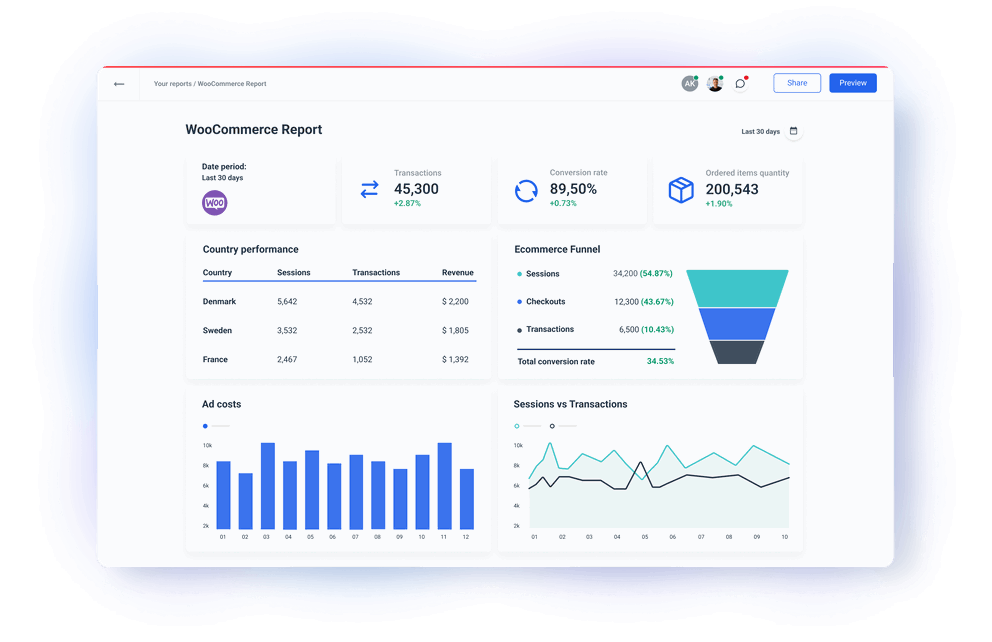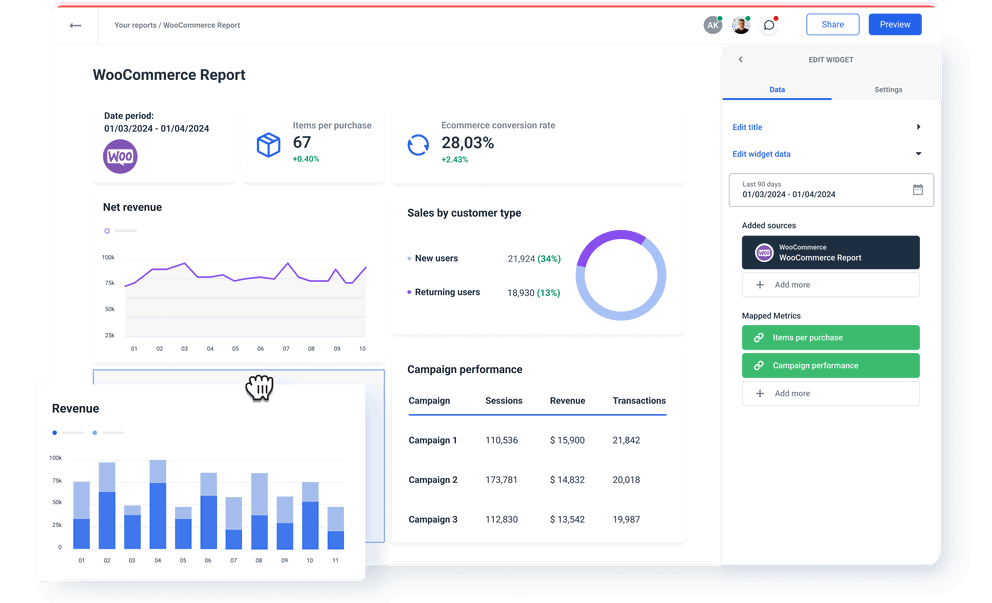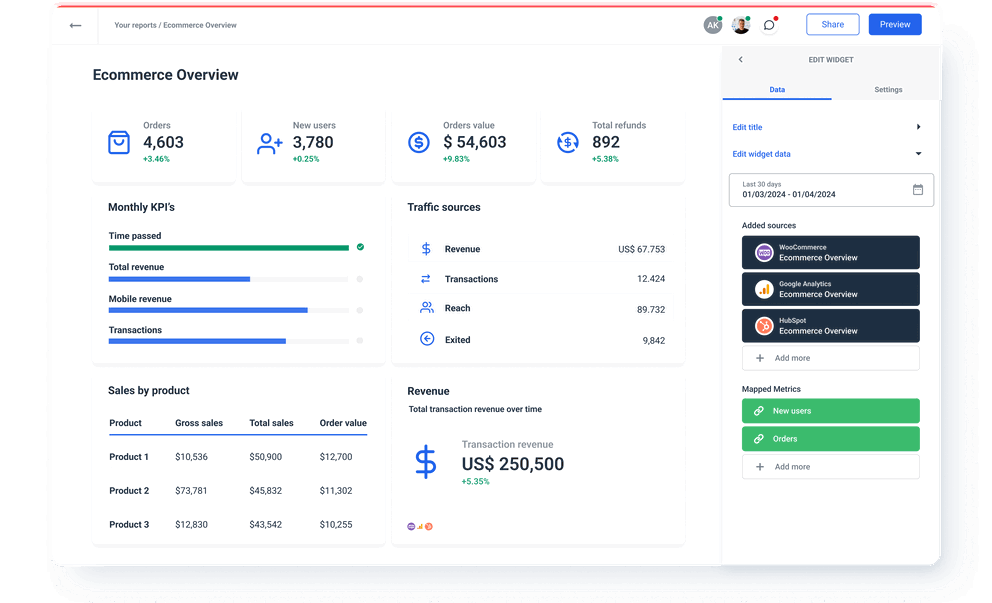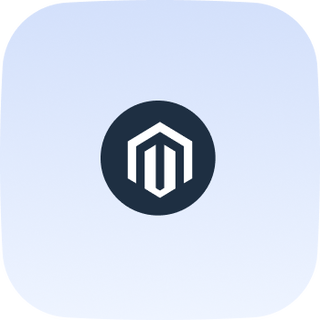WooCommerce Integration
Upgrade your e-commerce data management with our fully managed WooCommerce integration and user-friendly reports your clients will love to explore. Connect your WooCommerce store metrics and leverage Whatagraph’s superior visualization to identify trends and influence data-driven decisions. Blend and organize your WooCommerce data to get insights faster. Combine WooCommerce metrics with data from your CRM or paid ads. Automate the way you report to your clients or stakeholders.











Manage all your WooCommerce customer and sales data with a direct connector to WooCommerce API

Blend your WooCommerce metrics with conversion data from other ecommerce store platforms


WooCommerce metrics available instantly in Whatagraph
WooCommerce Performance
7WooCommerce Sales
9WooCommerce Top Sellers
1WooCommerce Coupons Totals
1WooCommerce Customers Totals
1WooCommerce Orders Totals
1Search...
Check out related integrations:
Explore marketing automation and custom report features




Frequently Asked Questions
What other marketing data sources can I connect alongside WooCommerce?
Apart from WooCommerce sources, you can connect other e-commerce platforms, Google Analytics 4, social media like Facebook Page and Instagram, SEO tools, PPC platforms like Google Ads and Amazon Advertising, CRMs like Salesforce and HubSpot, email marketing apps like Mailchimp and Klaiviyo.
If you can’t find the integration for your data source, connect it via a Custom API or export it to Google Sheets docs or BigQuery data warehouse and add it as a source.
Do I need a separate tool to visualize WooCommerce data?
No, you don’t need any other tool to visualize your WooCommerce data. Whatagraph is an all-in-one marketing data platform to connect, organize, visualize, and share all your data.
This makes Whatagraph a better choice than other data platforms that provide only the connection functionality, so users need to use a separate tool to visualize their WooCommerce data insights. Having one platform to connect, organize, visualize, and share insights from your marketing data saves time and allows for faster decision-making.
How to connect WooCommerce API to Whatagraph?
Whatagraph has a pre-built WooCommerce connector, so you don’t have to purchase and configure third-party data connectors. Adding a new WooCommerce source is simple:
1. Go to the Data Sources menu and locate WooCommerce among the channels.
2. Click +Add new in the Accounts column.
3. Enter the Shop URL (the string from your store admin URL), Consumer key, and Consumer secret (get it from your WooCommerce account settings) and click Add account.
4. The new WooCommerce source will appear.
You have successfully created a connection to your WooCommerce API. Create a custom report or dashboard and add your WooCommerce account as a source.
When you connect data from your online store to Whatagraph, you can organize datasets to get more granular insights by regions, customer demographics, or loyalty programs. You can visualize data in various widgets and share the insights via automated email attachments or live links for near real-time access.
What are the essential WooCommerce metrics I should track?
Tracking key metrics is essential for understanding the performance of your WooCommerce store and making informed decisions to optimize it. Here are some key metrics you should consider tracking:
Sales Revenue: Total sales revenue over time to gauge the overall health of your business.
Conversion Rate: The percentage of website visitors who make a purchase. This metric helps assess the effectiveness of your marketing efforts and user experience.
Average Order Value (AOV): The average amount customers spend per transaction. Increasing AOV can boost revenue without necessarily acquiring more customers.
Customer Lifetime Value (CLV): The total revenue a customer will generate throughout their relationship with your business. This metric helps prioritize customer retention efforts.
Customer Acquisition Cost (CAC): The average cost of acquiring a new customer. Comparing CAC to CLV helps ensure your marketing expenses are sustainable.
Shopping Cart Abandonment Rate: The percentage of users who add items to their cart but do not complete the purchase. Understanding why customers abandon their carts can help optimize checkout and reduce friction.
Website Traffic: The number of visitors to your website over time. Analyzing traffic sources and patterns can inform marketing strategies and identify areas for improvement.
Return on Investment (ROI): The effectiveness of your marketing campaigns by comparing the revenue generated to the cost of running the campaign.
Inventory Turnover Rate: How quickly inventory is sold and replaced within a specific time period. This metric helps manage inventory levels and avoid overstocking or stockouts.
Customer Retention Rate: The percentage of customers who make repeat purchases. A high retention rate indicates customer satisfaction and loyalty.
Product Performance: Sales data for individual products to identify top sellers, slow movers, and opportunities for optimization.
Abandoned Cart Recovery Rate: The percentage of abandoned carts recovered through follow-up emails or retargeting campaigns.
Regularly monitoring these key metrics allows you to gain valuable insights into your WooCommerce store's performance and make data-driven decisions to drive growth and profitability.
Effortlessly create reports and dashboards
What others think about Whatagraph
I made a switch from GDS and Sheets for reporting to Whatagraph, and I am saving literal hours each week on performance report creation. Our small firm actually managed to onboard 2 new clients as a result of all the time we saved on managing data and reporting. The customer service is also really helpful and easy to reach.
Having active customer support to help fix any issues was a big contributor, but we also really liked the ability to save templates and connect sources to multiple charts/widgets at once without having to edit them individually. And having the grid layout is much easier to stay consistent with than the free form setup that Data Studio has.
The system has standard templates that are easy and fast to use. Also you can build your own report with lightning speed. It is very easy to use, has a lot of integration, and let get started very fast.
We love Whatagraph - we would definitely recommend and our account manager is great! I love how easy this tool is to use, everyone on the team finds it much more user-friendly than other dashboards. Integration was easy, we sent some example reports to the team who duplicated these for us. We literally had to log in and send it to our clients!
We are showing our clients the work that we're doing for them and this is incredibly important for our clients ROI. They want to see results and having a tool like Whatagraph that can show data from virtually every source we use is hugely important.
The tool is easy to use; you do not need to have development resources. Even my junior project managers are capable of making campaign reports in minutes. There are a lot of pre-made templates you can use as well as many pre-made widgets.
Really easy to connect data sources within the tool. The library of report templates has been helpful. The customer support team has been responsive to all of our needs. Our team enjoys the simplicity of setting up the reports and how the data is presented.













